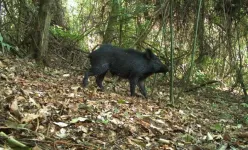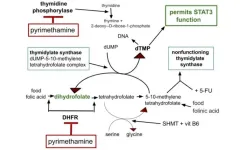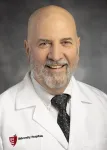(Press-News.org) There are no substitutes for native vegetation, but replacing large areas of monoculture with diversified crops in places where agricultural activities are widespread can have beneficial effects on the mammals that still inhabit the region.
This is one of the conclusions of a study conducted by researchers at the University of São Paulo (USP) supported by FAPESP. They focused on the northeast of São Paulo state, where the predominant biome is the Cerrado (Brazilian savanna). The region is one of the nation’s agribusiness centers.
An article on the study is published in the Journal of Applied Ecology. The study showed that land use conversion from extensive monoculture – the practice of growing a single crop over a large area – to diversified crops helped control invasive species that cause damage to farmers, such as the Wild boar (Sus scrofa).
The researchers analyzed the presence of native and exotic mammals in nine sampling sites across 55 units of 200 hectares (landscapes) – three in agricultural areas and six in native vegetation remnants. Plant cover was identified in patches of 3,000 hectares surrounding each unit. Altogether, the study area totaled 34,000 square kilometers touching on 80 municipalities in São Paulo state.
Data collected at each of the sites in 2017 and 2018 focused on tracks left by mammals, including footprints, droppings and other signs. The researchers also installed cameras in areas of native vegetation.
“The composition of these landscapes was more or less heterogeneous, with a mixture of native vegetation, monoculture and various crops. We looked for correlations between the degree of heterogeneity and the presence or absence of native and exotic mammals,” said Marcella do Carmo Pônzio, first author of the article. She is currently a PhD candidate at the Institute of Biosciences (IB-USP).
The impact of heterogeneity on the landscape was equivalent to 80% of the effect of areas of Cerrado in the region on the number of native species in that context. Furthermore, diversification of plant cover reduced the number of invasive species, such as boars, by 27%.
“Although more sensitive species, such as the Jaguar [Panthera onca], have disappeared, greater landscape complexity can mean more mammals belonging to native species, such as the Puma [Puma concolor] and the Giant armadillo [Priodontes maximus], for example, and fewer belonging to invasive species. In areas of monoculture with little native vegetation, on the other hand, boars predominate,” Pônzio said. She obtained part of the results while she was a researcher at the Ribeirão Preto School of Philosophy, Sciences and Letters (FFCLRP-USP) with a scholarship from FAPESP.
The study was part of the project “Occurrence of mammals and biological invasion in Cerrado remnants of agricultural landscapes”, supported by FAPESP. The principal investigator for the project was Adriano Garcia Chiarello, a professor at FFCLRP-USP and Pônzio’s supervisor for her master’s research.
“Most properties in the study area don’t even comply with the Forest Code,” Chiarello said, referring to a federal law that requires conservation of 20% of the native vegetation in properties in the Cerrado, in addition to river banks and hills, which are classed as Permanent Protection Areas (Portuguese-language acronym APPs).
Even if the owners of these areas complied with the rule, he added, 20% is not sufficient for wildlife to survive and for maintenance of ecosystem services such as water supply, carbon storage and climate regulation.
Although this was not the focus for the study, research by other groups has shown that at least 35%-40% of the native vegetation should be conserved in order to maintain biodiversity and ecosystem services.
Diversification
As expected, the existence of native vegetation was the factor that most influenced native mammal richness, defined as the number of individuals recorded across the nine sites per landscape. The species observed include P. concolor and the Maned wolf (Chrysocyon brachyurus).
These species are generalists, however, and more adaptable to degraded areas. Mammals that have historically inhabited the Cerrado, such as P. onca, P. maximus and the Peccary (Tayassu pecari), have become locally extinct.
Native vegetation was also the factor that most influenced reductions in numbers of invasive species, such as the Domestic dog (Canis lupus familiaris), the European hare (Lepus europaeus), and above all S. scrofa, which in Brazil is a hybrid species that was originally introduced by breeders. Boars are considered an agricultural pest, as they are omnivorous and eat many crops and other plants. The study detected them mostly in areas with monocultures such as sugarcane and little native vegetation.
The good news amid all this degradation and species loss was that crop diversification mitigated the effects of a lack of native vegetation. In other words, native species richness was supported in agricultural areas with more diversified plant cover, such as family farms and other properties that focus on food production, as well as integrated crop-livestock-forestry systems, and exotic species tended to be kept out of such areas.
“The findings suggest that policymakers should perhaps not focus solely on halting deforestation but should also combat simplification of the landscape. Even more than deforestation, we need to concern ourselves with what is done in areas that were once Cerrado,” said Renata Pardini, last author of the article. She is a professor at IB-USP and Ponzio’s PhD thesis advisor.
As a positive model, Pardini cited Refloresta-SP, a program coordinated since 2022 by the São Paulo State Department of Environment, Infrastructure and Logistics to restore degraded ecosystems and areas, develop multifunctional forests and implement agroforestry systems with the aim of promoting economic as well as ecological improvements.
Native species are used in conjunction with non-native species to generate income for farmers and assure the provision of important ecosystem services even for traditional cropping systems. The program involves a partnership with BIOTA Synthesis, a Science for Development Center funded by FAPESP and hosted by USP. Both Pônzio and Pardini are members (read more at: agencia.fapesp.br/38760).
The researchers stress the importance of maintaining and creating legally protected areas of Cerrado in São Paulo state, where native vegetation is found in only 20% of the region. In the study area, for example, the largest protected area is the Jataí Ecological Station, with only 9,075 hectares.
“We don’t suppose diversified agriculture would offset the environmental damage done by deforestation and monoculture. Our data shows it’s important but no substitute for the role of native vegetation,” Pônzio said.
The study was also supported by FAPESP via a doctoral scholarship and a research internship at Colorado State University in the United States awarded to Nielson Pasqualotto.
The other co-author of the article is Marina Zanin, a researcher at IB-USP who at the time of the study was supported by FAPESP via a postdoctoral scholarship.
About São Paulo Research Foundation (FAPESP)
The São Paulo Research Foundation (FAPESP) is a public institution with the mission of supporting scientific research in all fields of knowledge by awarding scholarships, fellowships and grants to investigators linked with higher education and research institutions in the State of São Paulo, Brazil. FAPESP is aware that the very best research can only be done by working with the best researchers internationally. Therefore, it has established partnerships with funding agencies, higher education, private companies, and research organizations in other countries known for the quality of their research and has been encouraging scientists funded by its grants to further develop their international collaboration. You can learn more about FAPESP at www.fapesp.br/en and visit FAPESP news agency at www.agencia.fapesp.br/en to keep updated with the latest scientific breakthroughs FAPESP helps achieve through its many programs, awards and research centers. You may also subscribe to FAPESP news agency at http://agencia.fapesp.br/subscribe.
END
In the Cerrado, crop diversification has beneficial effects on wildlife and reduces the presence of boars
Sus scrofa causes damage to farmers in an important part of Brazil’s savanna-like biome. The researchers analyzed 55 landscapes in São Paulo state, observing larger numbers of native mammals in areas with well-conserved vegetation and diversified crop
2024-02-09
ELSE PRESS RELEASES FROM THIS DATE:
How electron spectroscopy measures exciton “holes”
2024-02-09
Semiconductors are ubiquitous in modern technology, working to either enable or prevent the flow of electricity. In order to understand the potential of two-dimensional semiconductors for future computer and photovoltaic technologies, researchers from the Universities of Göttingen, Marburg and Cambridge investigated the bond that builds between the electrons and holes contained in these materials. By using a special method to break up the bond between electrons and holes, they were able to gain a ...
IPIAD: an augmentation to standard treatment of PDAC using five repurposed drugs
2024-02-09
“This paper presents the rationale for adding five already approved and marketed generic drugs from general medical practice to the current standard current first line chemotherapy for pancreatic ductal adenocarcinoma (PDAC).”
BUFFALO, NY- February 9, 2024 – A new research perspective was published in Oncoscience (Volume 11) on February 7, 2024, entitled, “IPIAD- an augmentation regimen added to standard treatment of pancreatic ductal adenocarcinoma using already-marketed repurposed drugs irbesartan, pyrimethamine, itraconazole, azithromycin, and dapsone.”
In this new paper, researcher Richard E. Kast from IIAIGC Study Center presents the ...
UT Health San Antonio School of Dentistry opens dental clinic for special-needs children, adults
2024-02-09
SAN ANTONIO, Feb. 9, 2024 – The UT Health San Antonio School of Dentistry has opened a special-care dental clinic, the first of its kind in an academic setting in South Texas that will serve people of all ages with intellectual, developmental, cognitive or physical disabilities.
With spacious, specially designed treatment rooms featuring adjustable sound and lighting and even a “Zen Den” multi-sensory room to help reduce anxiety, the Phil and Karen Hunke Special Care Clinic occupies approximately ...
This ultrasound sticker senses changing stiffness of deep internal organs
2024-02-09
MIT engineers have developed a small ultrasound sticker that can monitor the stiffness of organs deep inside the body. The sticker, about the size of a postage stamp, can be worn on the skin and is designed to pick up on signs of disease, such as liver and kidney failure and the progression of solid tumors.
In an open-access study that will appear in Science Advances, the team reports that the sensor can send sound waves through the skin and into the body, where the waves reflect off internal organs and back out to the sticker. The pattern of the reflected waves can be read as ...
Yale joins the ‘Snowball’ fight over global deep freeze periods
2024-02-09
New Haven, Conn. — A Yale-led research team has picked a side in the “Snowball Earth” debate over the possible cause of planet-wide deep freeze events that occurred in the distant past.
According to a new study, these so-called “Snowball” Earth periods, in which the planet’s surface was covered in ice for thousands or even millions of years, could have been triggered abruptly by large asteroids that slammed into the Earth.
The findings, detailed in the journal Science Advances, may answer a question ...
Sensors made from ‘frozen smoke’ can detect toxic formaldehyde in homes and offices
2024-02-09
Researchers have developed a sensor made from ‘frozen smoke’ that uses artificial intelligence techniques to detect formaldehyde in real time at concentrations as low as eight parts per billion, far beyond the sensitivity of most indoor air quality sensors.
The researchers, from the University of Cambridge, developed sensors made from highly porous materials known as aerogels. By precisely engineering the shape of the holes in the aerogels, the sensors were able to detect the fingerprint of formaldehyde, a common indoor air pollutant, at room temperature.
The proof-of-concept sensors, which require minimal power, could be adapted to detect ...
University Hospitals now offering FDA-approved medication for treatment of Alzheimer’s disease
2024-02-09
CLEVELAND—University Hospitals (UH) Brain Health & Memory Center is now treating patients with LEQEMBI® (lecanemab), a Food and Drug Administration-approved medication for the treatment of Alzheimer’s disease.
“Those with Alzheimer’s disease often have an abnormal buildup of plaques in their brain that contain a protein called beta-amyloid,” said Charles J. Duffy, MD, PhD, neurologist and Director of the Brain Health & Memory Center within the UH Neurological Institute. “Lecanemab ...
Unlocking quantum precision: Expanded superconducting strips for enhanced photon-counting accuracy
2024-02-09
Using single photons as qubits has become a prominent strategy in quantum information technology. Accurately determining the number of photons is crucial in various quantum systems, including quantum computation, quantum communication, and quantum metrology. Photon-number-resolving detectors (PNRDs) play a vital role in achieving this accuracy and have two main performance indicators: resolving fidelity, which measures the probability of accurately recording the number of incident photons, and dynamic range, which describes the maximum resolvable photon number.
Superconducting nanostrip single-photon detectors (SNSPDs) are considered the leading ...
From growing roots, clues to how stem cells decide their fate
2024-02-09
DURHAM, N.C. -- It might look like a comet or a shooting star, but this time-lapse video is actually a tiny plant root, not much thicker than a human hair, magnified hundreds of times as it grows under the microscope.
Researchers at Duke University have been making such movies by peering at stem cells near the root’s tip and taking snapshots as they divide and multiply over time, using a technique called light sheet microscopy.
The work offers more than a front row seat to the drama of growing roots. By watching how the cells divide in response to certain chemical signals, the team is finding new clues to how stem cells choose one ...
UK's Nursing’s Stanifer chosen as scholar in Environmental Health Research Institute for Nurse and Clinician Scientists
2024-02-09
LEXINGTON, Ky. (Feb. 8, 2024) — A researcher in the University of Kentucky College of Nursing has been selected as a scholar for the Environmental Health Research Institute for Nurse and Clinician Scientists (EHRI-NCS).
EHRI-NCS is a year-long flipped classroom, train-the-trainer and mentorship program aimed at developing a new era of environmental health nursing science. It’s led by Castner Incorporated, a health research company, in partnership with Emory University, Washington State University and University of Alabama in Huntsville.
Stacy Stanifer, Ph.D., an advanced practice registered nurse and an assistant professor of nursing, was selected to participate. ...
LAST 30 PRESS RELEASES:
When tropical oceans were oxygen oases
Positive interactions dominate among marine microbes, six-year study reveals
Safeguarding the Winter Olympics-Paralympics against climate change
Most would recommend RSV immunizations for older and pregnant people
Donated blood has a shelf life. A new test tracks how it's aging
Stroke during pregnancy, postpartum associated with more illness, job status later
American Meteorological Society announces new executive director
People with “binge-watching addiction” are more likely to be lonely
Wild potato follows a path to domestication in the American Southwest
General climate advocacy ad campaign received more public engagement compared to more-tailored ad campaign promoting sustainable fashion
Medical LLMs may show real-world potential in identifying individuals with major depressive disorder using WhatsApp voice note recordings
Early translational study supports the role of high-dose inhaled nitric oxide as a potential antimicrobial therapy
AI can predict preemies’ path, Stanford Medicine-led study shows
A wild potato that changed the story of agriculture in the American Southwest
Cancer’s super-enhancers may set the map for DNA breaks and repair: A key clue to why tumors become aggressive and genetically unstable
Prehistoric tool made from elephant bone is the oldest discovered in Europe
Mineralized dental plaque from the Iron Age provides insight into the diet of the Scythians
Salty facts: takeaways have more salt than labels claim
When scientists build nanoscale architecture to solve textile and pharmaceutical industry challenges
Massive cloud with metallic winds discovered orbiting mystery object
Old diseases return as settlement pushes into the Amazon rainforest
Takeaways are used to reward and console – study
Velocity gradients key to explaining large-scale magnetic field structure
Bird retinas function without oxygen – solving a centuries-old biological mystery
Pregnancy- and abortion-related mortality in the US, 2018-2021
Global burden of violence against transgender and gender-diverse adults
Generative AI use and depressive symptoms among US adults
Antibiotic therapy for uncomplicated acute appendicitis
Childhood ADHD linked to midlife physical health problems
Patients struggle to measure blood pressure at home
[Press-News.org] In the Cerrado, crop diversification has beneficial effects on wildlife and reduces the presence of boarsSus scrofa causes damage to farmers in an important part of Brazil’s savanna-like biome. The researchers analyzed 55 landscapes in São Paulo state, observing larger numbers of native mammals in areas with well-conserved vegetation and diversified crop





